Cottage Cheese Cheesecake is changing the dessert game. Let’s be real, regular cheesecake is delicious, but it can be a calorie bomb loaded with fat and sugar. For anyone chasing a healthier lifestyle, that’s a tough craving to manage.
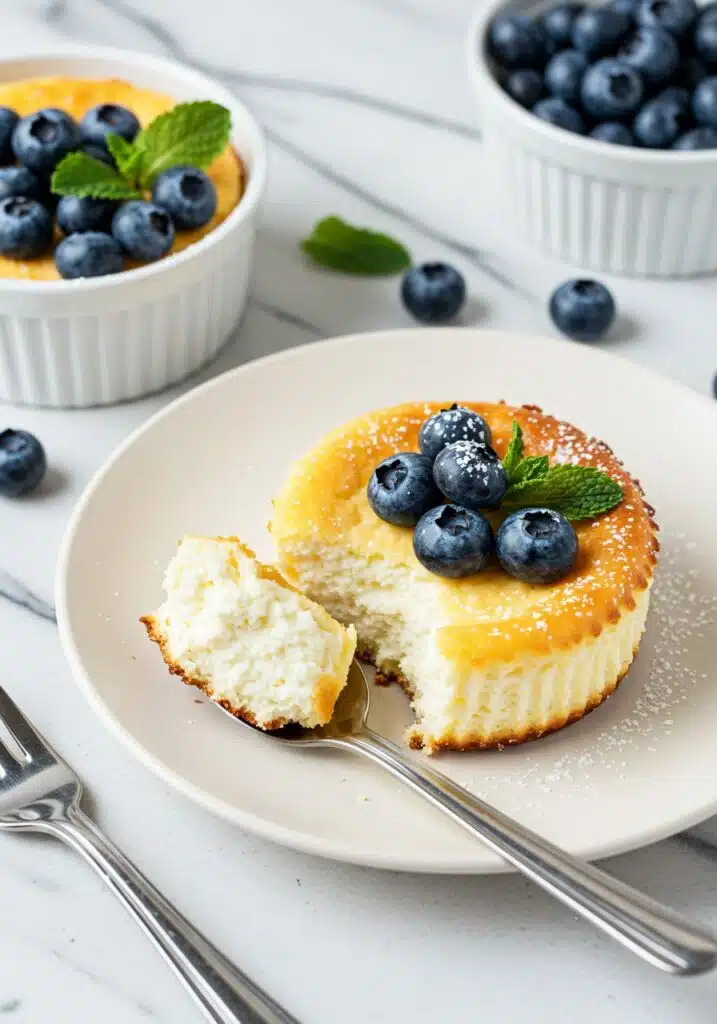
This recipe was inspired by popular high-protein cooking methods that swap heavy cream cheese for blended cottage cheese. The result? A cheesecake that’s lighter, packed with protein, and still ridiculously creamy. Whether you’re into fitness, managing weight, or just love guilt-free desserts, this is one worth bookmarking.
Think of it as the best of both worlds: indulgent flavor without the diet crash. And honestly, who doesn’t want dessert that actually supports their health goals? If you love high-protein meal ideas or Cottage cheese desserts, this cheesecake fits right in.
Why Make Cheesecake with Cottage Cheese?
Why cottage cheese? Simple, this swap transforms cheesecake into a protein powerhouse. Instead of the typical fat-heavy base, you’re getting a lighter dairy option that blends smooth and adds a serious protein boost.
Cottage cheese cheesecake is especially popular among fitness-focused home cooks. Many say this trick makes a huge difference when you want dessert without sacrificing macros. It’s also more budget-friendly compared to blocks of cream cheese.
►And don’t worry, when blended smooth, the mild, slightly sweet flavor of cottage cheese provides the perfect creamy base without any of the tangy or savory notes you’d expect. The curds turn into a velvety texture that rivals traditional cream cheese when processed correctly.
►Another win? Cottage cheese naturally has less sugar and sodium. That means your cheesecake isn’t just creamy, it’s also aligned with common diet goals like low-carb, bariatric-friendly, or weight-loss-focused eating. For more on how protein helps with satiety and muscle repair, check Harvard’s Nutrition Source on protein.
Cottage Cheese Cheesecake Recipe (Step-by-Step)
This recipe is all about keeping things simple, quick, and nutritious. Prep time is 5 minutes, bake time 25 minutes, and it yields a single-serving cheesecake, perfect for meal prep or weeknight cravings.
Another expert trick: Drain your cottage cheese in a fine-mesh sieve for 15 minutes before blending. This removes excess liquid and helps your cheesecake set firm instead of turning runny. Also, make sure your egg and yogurt are at room temperature, cold ingredients often cause lumps.
Ingredients
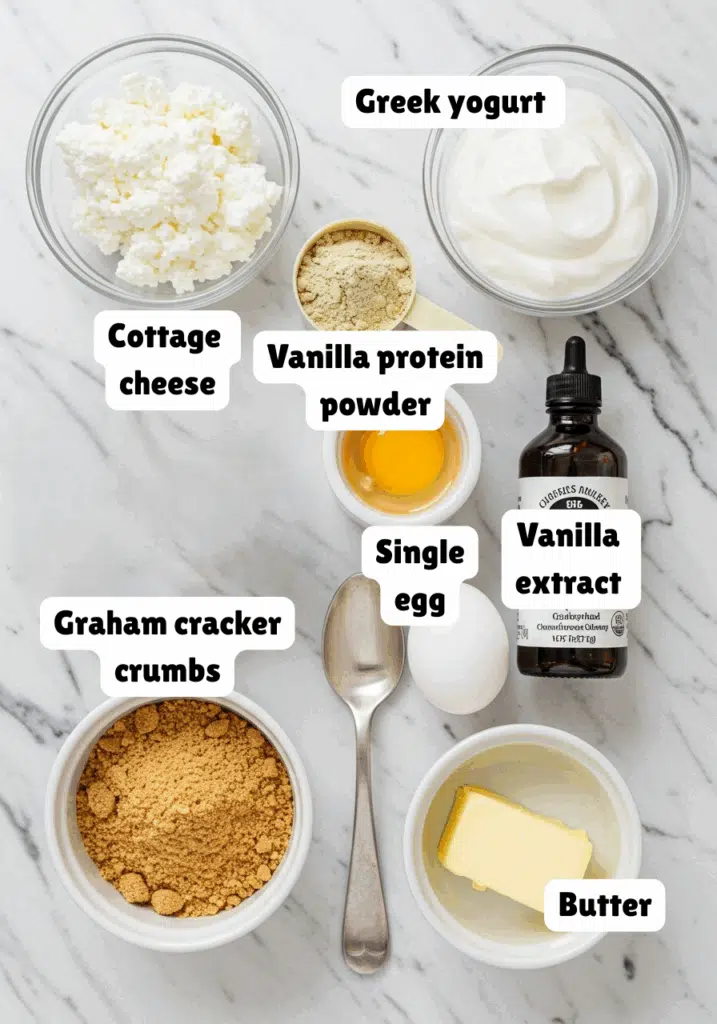
Crust:
- 15 g graham cracker crumbs (your choice of brand)
- ½ tablespoon butter (unsalted or salted)
Filling:
- 1 large whole egg, room temperature
- ½ cup cottage cheese, drained and full-fat for best results
- ½ teaspoon vanilla extract
- 1 tablespoon sweetener (sugar substitute or sugar)
- 1 scoop protein powder (vanilla works best; chocolate or unflavored optional)
- 1 tablespoon Greek yogurt (flavor should complement your protein powder)
Instructions
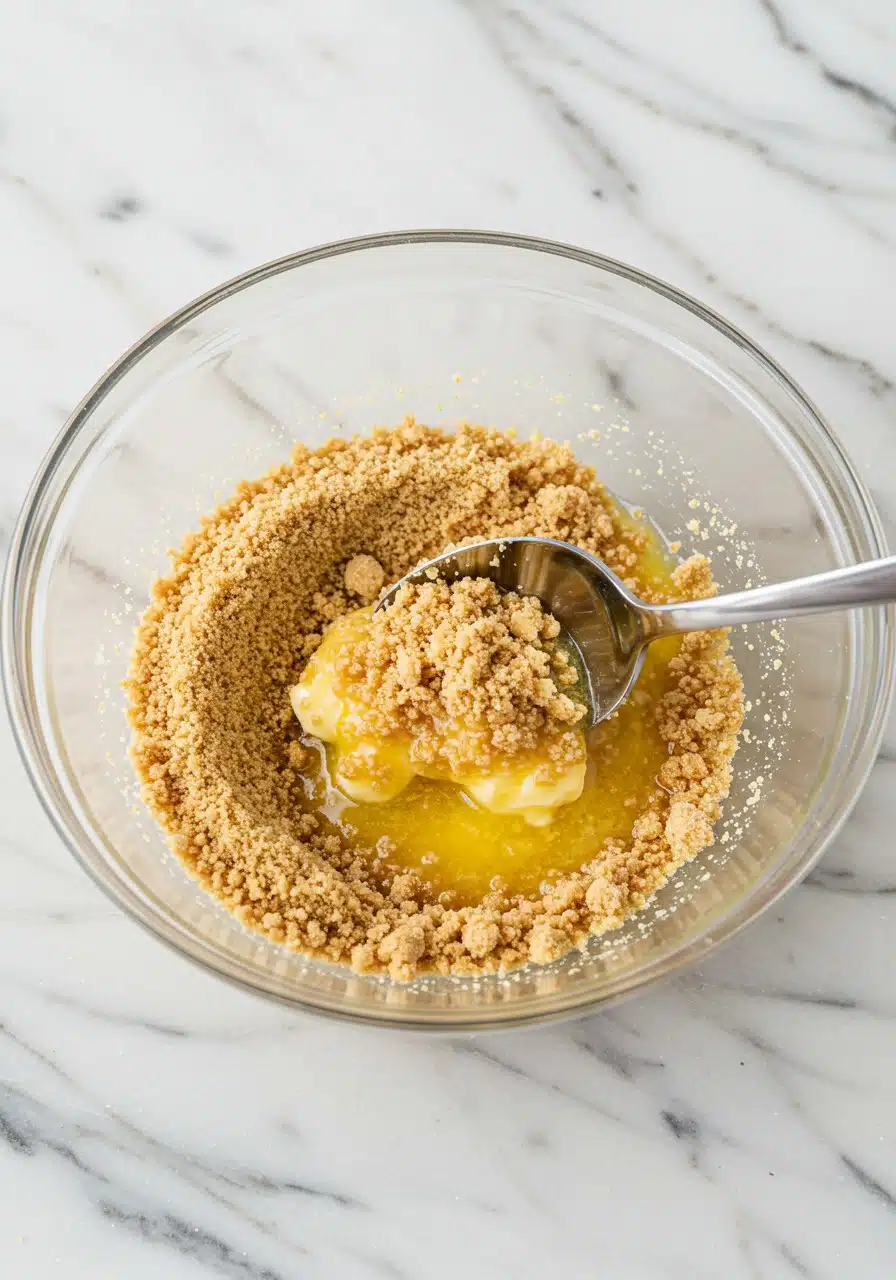
1. Prepare the crust: Mix graham cracker crumbs with melted butter. Press into the bottom of your ramekin or baking dish. Bake at 375°F (190°C) for 5–7 minutes until golden.
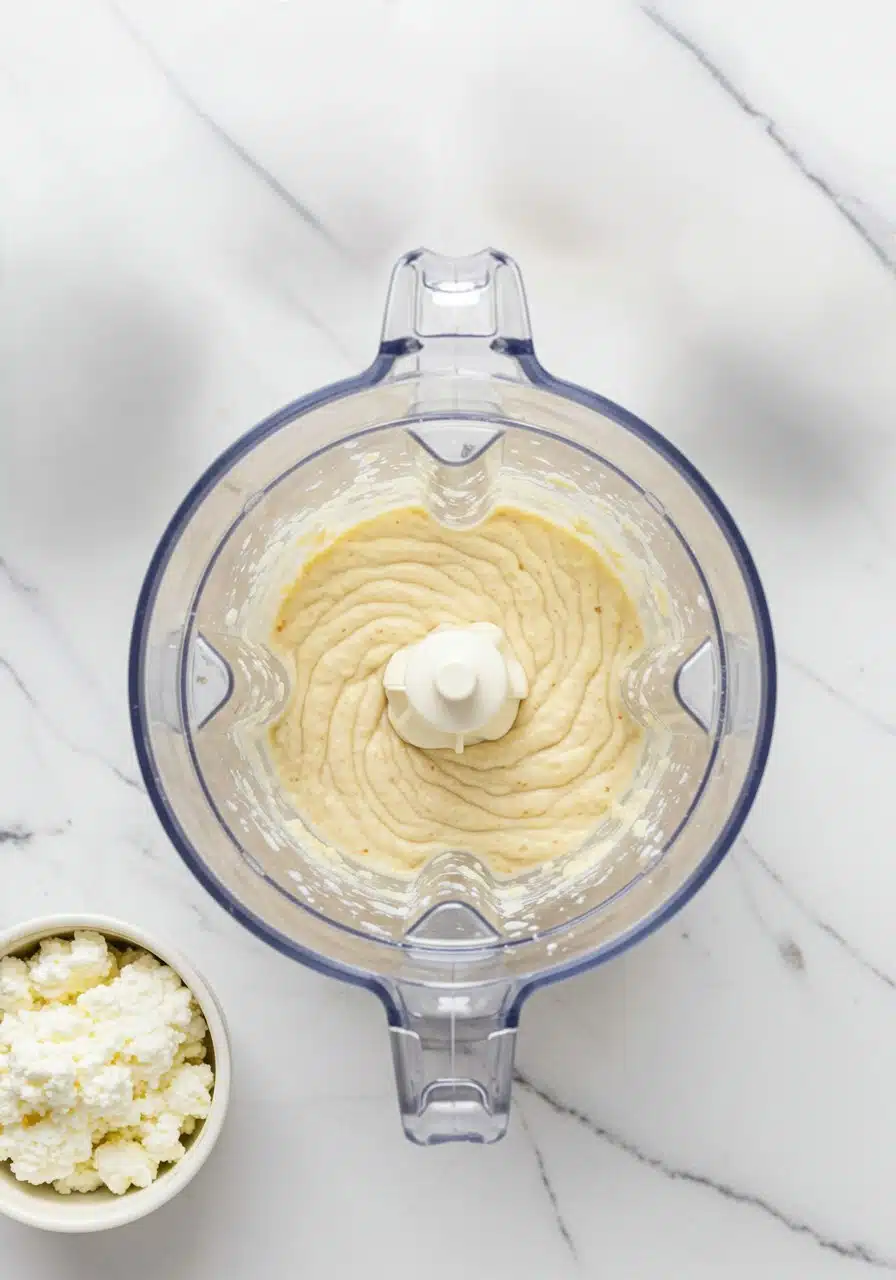
2. Make the filling: In a blender or food processor, combine drained cottage cheese, egg, vanilla, sweetener, protein powder, and Greek yogurt. Blend until completely smooth, this is crucial for avoiding lumps.
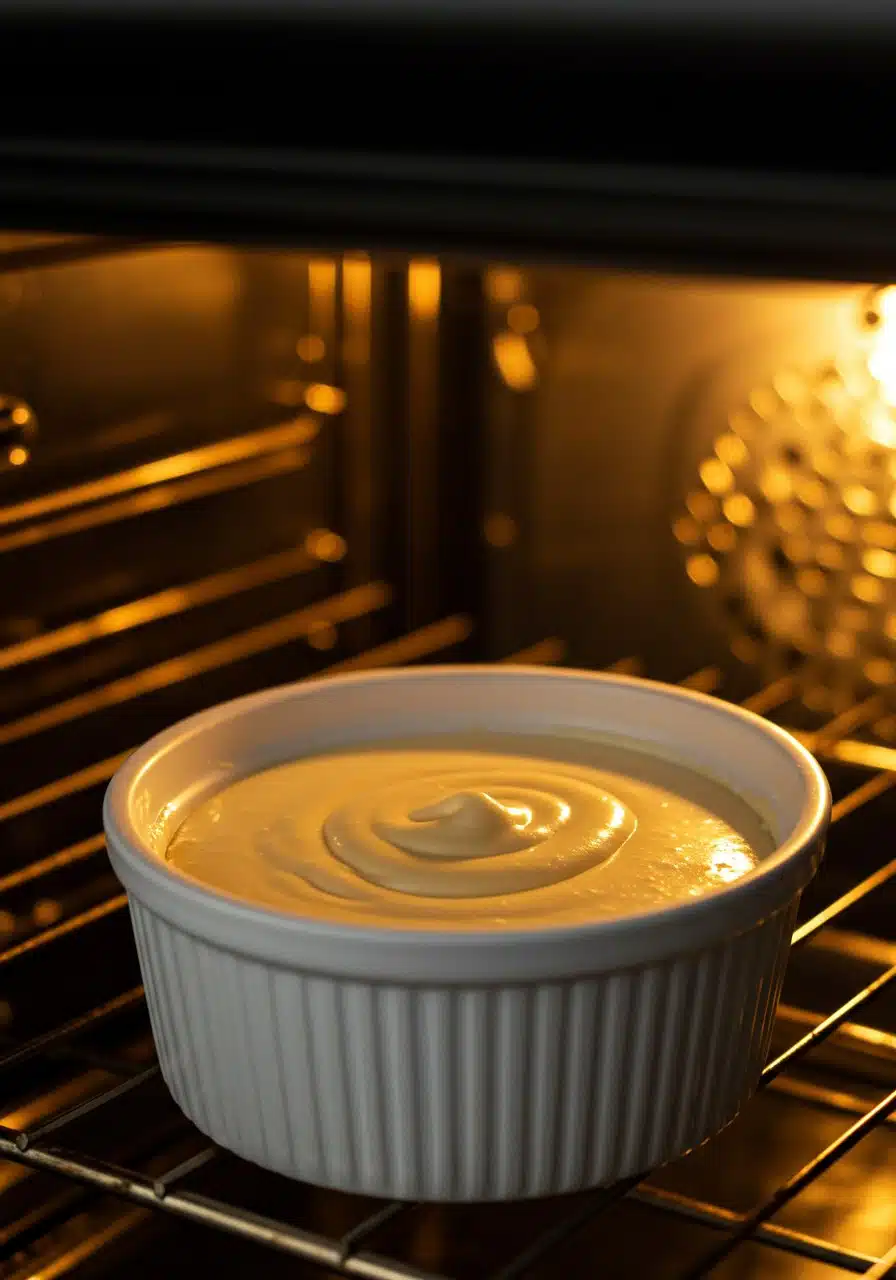
3. Bake the cheesecake: Pour the mixture over the baked crust. Bake at 325°F (160°C) for 20–25 minutes. The center should jiggle slightly but not look raw.
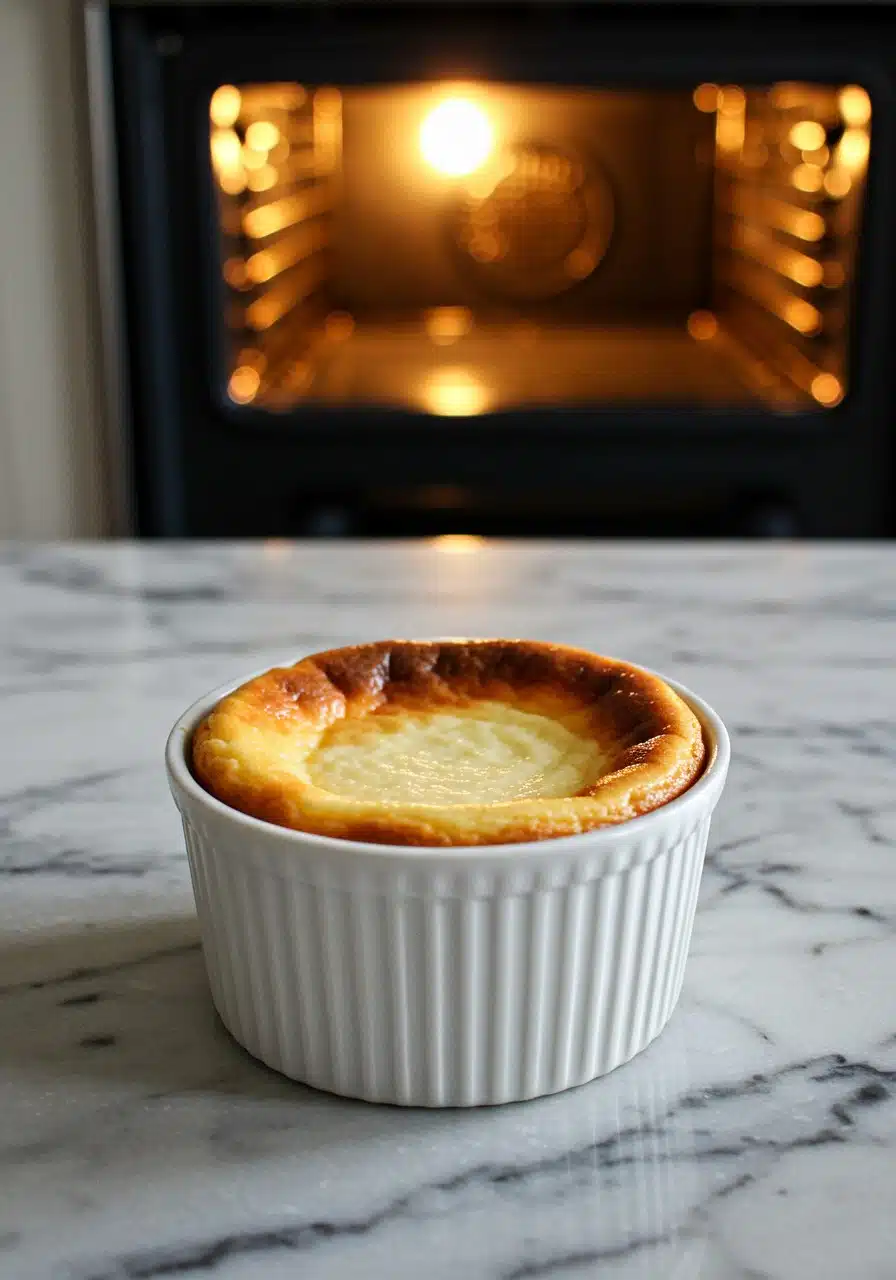
4. Cool properly: Turn off the oven and leave the cheesecake inside with the door cracked open for 1 hour to prevent cracks. Then cool on the counter until room temperature. Finally, refrigerate for 3–4 hours before slicing.
Nutrition & Macros for Cottage Cheese Cheesecake
Compared to traditional cheesecake, this version has less fat, fewer carbs, and a big protein punch.
| Serving Size | Calories | Protein | Carbs | Fat | Sugar |
|---|---|---|---|---|---|
| Cheesecake (no crust) | 291 kcal | 43 g | 14 g | 7 g | 6 g |
| Small crust only | 115 kcal | 1 g | 12 g | 7 g | 2.5 g |
►Note: Nutritional info varies based on protein powder and cottage cheese brand. Whey isolates generally have fewer carbs than blends, while full-fat cottage cheese increases calories slightly.
A slice of cottage cheese cheesecake can deliver 12–25 grams of protein, depending on portion and protein powder. That’s roughly the same as a chicken breast, but in dessert form. No joke.
If you track macros, this dessert fits nicely into weight management plans, strength training routines, or even bariatric recovery meals when portioned correctly.
Tips for the Perfect Protein Cheesecake
- Blend thoroughly: Cottage cheese curds must be fully blended for a silky texture.
- Chill properly: Refrigeration helps the cheesecake set and gives that dense, creamy bite.
- Choose the right protein powder: Casein creates a denser texture; whey bakes lighter. Many bakers use a whey-casein blend for balance.
- Use a water bath for larger cheesecakes: Wrap the pan in foil and place in a roasting pan with hot water halfway up. This prevents cracks and maintains creamy texture.
- Don’t overbake: The center should jiggle slightly; it will continue to set as it cools. Overbaking can scramble the eggs and ruin texture.
These small tweaks turn a simple recipe into a pro-level cheesecake, without the sugar crash.
Troubleshooting Common Issues with Cottage Cheese Cheesecake
Even the best recipes can hit a snag, so let’s cover the most common challenges and how to fix them.
Grainy Texture – This happens when the cottage cheese curds aren’t blended thoroughly. Always drain the cheese and process until completely smooth. Using room temperature eggs and yogurt also helps create that velvety, bakery-style texture.
Cheesecake Doesn’t Set – A loose or watery cheesecake is often caused by excess liquid or overbaking. Make sure to drain the cottage cheese, follow the precise bake time, and allow proper chilling.
Cracks on Top – A cracked surface usually comes from rapid cooling or overbaking. Gradual cooling is key: leave the cheesecake in the oven with the door slightly ajar for 1 hour, then bring it to room temperature before refrigerating. Why this works: slow cooling prevents the cheesecake from contracting too quickly, which is what causes cracks.
Too Sweet or Too Bland – Protein powders can alter sweetness and flavor. If using flavored powders, adjust the sweetener to taste. Vanilla or unflavored protein works best for a neutral flavor, while chocolate adds a dessert twist but can dominate subtle notes.
expert tips
►1. Tip: For the creamiest texture, use full-fat cottage cheese (4% or higher). Reduced-fat works too, but full-fat gives a richer, denser bite.
►2. Tip: Add a teaspoon of lemon juice for brightness, or use chocolate protein powder for a dessert-style twist.
►3. Tip: Many fitness enthusiasts blend half whey and half casein protein powder, it balances texture, moisture, and flavor beautifully. For more protein tips and benefits, check Harvard’s Nutrition Source.
Cottage Cheese Cheesecake Variations
Keep things fun and on-trend with these creative twists.
Fruit-Forward Options
- Blueberry Lemon Cheesecake: Fold in 1/4 cup fresh blueberries and 1 tsp lemon zest before baking.
- Mango Passionfruit Swirl: Fold in 2–3 tbsp mango puree and 1 tbsp passionfruit pulp for a tropical flavor.
Indulgent Flavors
- Chocolate Hazelnut Protein Cheesecake: Add 1 tbsp unsweetened cocoa powder and swirl in 1/2 tbsp hazelnut spread.
- Peanut Butter Swirl: Mix 1 tbsp natural peanut butter into the filling for a rich, nutty taste.
Low-Carb / No-Crust Versions
- Skip the crust and bake in a greased ramekin. You’ll save carbs and calories while keeping the creamy texture intact.
Tips for Variations:
- Adjust sweeteners carefully, fruit adds natural sugar, while protein powders can taste bitter if overused.
- Consider portioning into mini ramekins; smaller servings are great for meal prep and calorie control.
Storage & Meal Prep
Cottage Cheese Cheesecake is fridge- and freezer-friendly, perfect for fitness-conscious meal prep.
Fridge:
- Store in an airtight container for up to 5 days.
- Slice just before serving to maintain texture.
Freezer:
- Wrap individual portions in plastic wrap and store in a freezer-safe container for up to 1 month.
- Thaw in the fridge overnight before enjoying.
Meal Prep Tips:
- Portion into small ramekins for single servings. they make excellent high-protein snacks or post-workout desserts.
- Top with fresh berries, cocoa nibs, or a light drizzle of nut butter right before serving.
►Insider Hack: Freezing small portions helps maintain creamy texture and prevents the cheesecake from turning watery.
Frequently Asked Questions (FAQ)
Can you taste the cottage cheese in this cheesecake?
A: Not really! When blended thoroughly, cottage cheese becomes a smooth, creamy base. Its mild, slightly sweet flavor is subtle, making it taste more like traditional cheesecake than you’d expect.
How do I make my cottage cheese cheesecake not grainy?
Drain the cottage cheese and blend until silky smooth. Room temperature eggs and yogurt also help achieve velvety texture. Avoid overbaking, as it can curdle the mixture.
Is cottage cheese cheesecake good for weight loss?
Absolutely. High protein, lower fat, and fewer carbs than traditional cheesecake make it a satisfying dessert that fits into calorie-controlled or high-protein meal plans.
Can I make this cheesecake without protein powder?
Yes! Simply add extra Greek yogurt or cottage cheese to maintain structure and creaminess.
Is this dessert bariatric-friendly?
When portioned correctly and using low-sugar sweeteners, it’s suitable for bariatric diets. Small servings help meet protein needs without excess calories.
Does it matter if I use full-fat or low-fat cottage cheese?
Both work, but full-fat (4% milkfat or higher) gives the creamiest texture. Low-fat versions are still delicious but slightly less dense.
Final Thoughts
Cottage Cheese Cheesecake proves that healthy can still be indulgent. It’s creamy, high-protein, and flexible enough to suit almost any dietary goal, from fitness enthusiasts to dessert lovers watching calories.
Key Takeaways:
- Drain the cottage cheese for a firm texture
- Blend ingredients thoroughly for velvety smoothness
- Chill properly to prevent cracks
- Choose the right protein powder (whey, casein, or a blend)
- Experiment with flavors and portion sizes for variety
►Try it and let us know how it worked for you! Share your favorite variations in the comments and inspire others to enjoy a guilt-free, protein-packed cheesecake.
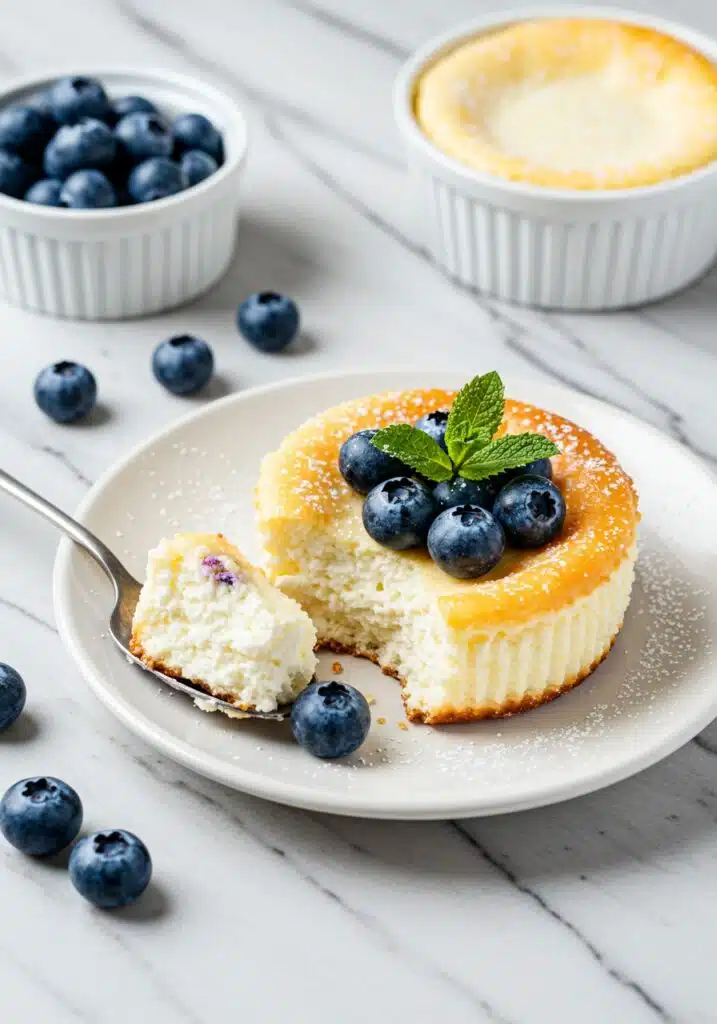
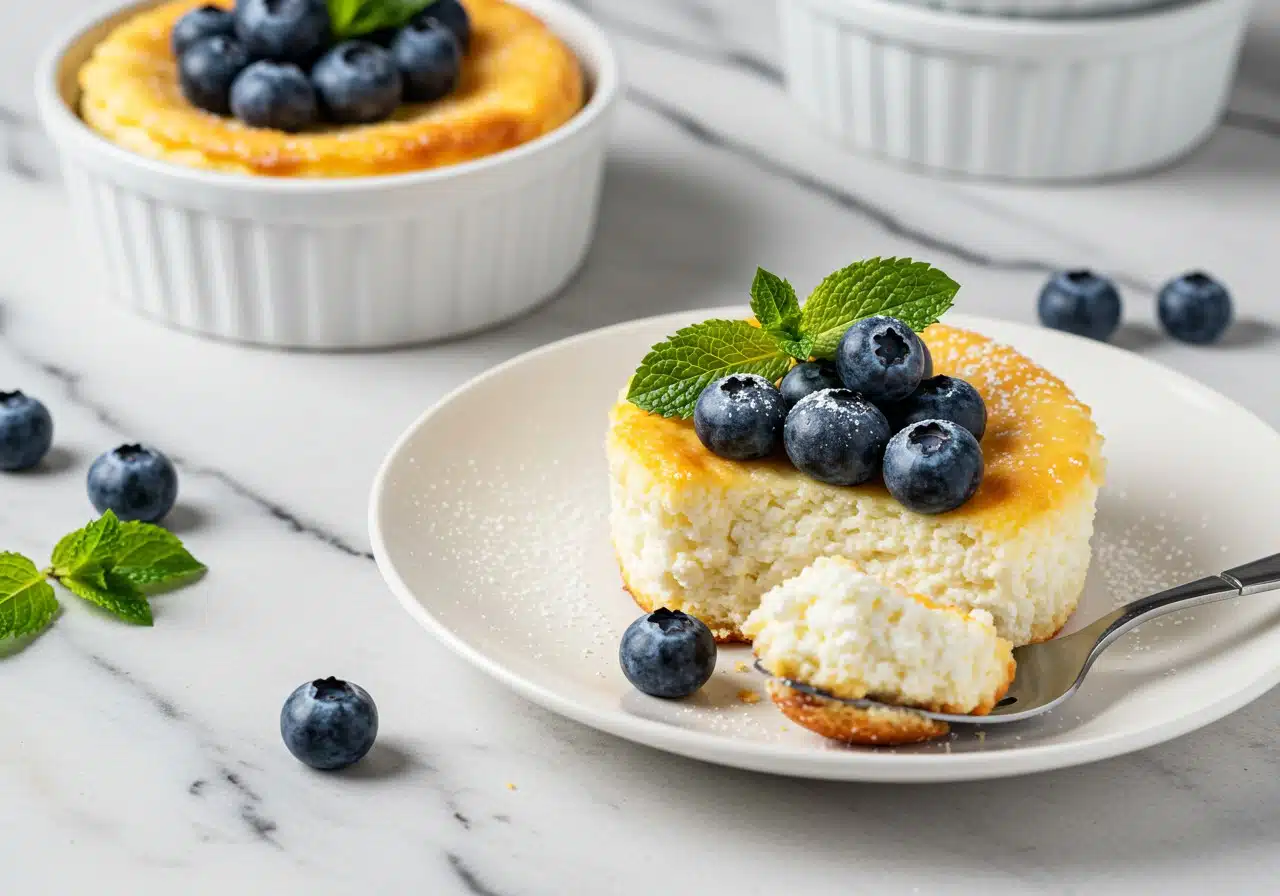
Easy Cottage Cheese Cheesecake (High-Protein & Healthy)
- Total Time: 35 minutes + chilling
- Yield: 1–2 servings 1x
Description
Easy Cottage Cheese Cheesecake that’s creamy, protein-packed, and perfect for a guilt-free dessert. Made with cottage cheese, protein powder, and Greek yogurt, this single-serve cheesecake delivers indulgent flavor without the heavy calories of traditional versions.
Equipment Needed
-
- Ramekin or Small Baking Dish (6–8 oz) – for individual cheesecakes.
- Blender or Food Processor – to blend cottage cheese until smooth (a must-have for creamy texture).
- Mixing Bowl – for combining crust ingredients.
- Measuring Cups & Spoons – for accuracy with protein powder, crumbs, and yogurt.
- Whisk or Spatula – to stir and fold ingredients.
Ingredients
Crust:
- 15 g graham cracker crumbs (your choice of brand)
- 1/2 tablespoon butter (unsalted or salted)
Filling:
- 1 large whole egg, room temperature
- 1/2 cup cottage cheese, drained and full-fat for best results
- 1/2 teaspoon vanilla extract
- 1 tablespoon sweetener (sugar substitute or sugar)
- 1 scoop protein powder (vanilla works best; chocolate or unflavored optional)
- 1 tablespoon Greek yogurt (flavor should complement your protein powder)
Instructions
- Prepare the crust: Mix graham cracker crumbs with melted butter. Press into the bottom of your ramekin or baking dish. Bake at 375°F (190°C) for 5–7 minutes until golden.
- Make the filling: In a blender or food processor, combine drained cottage cheese, egg, vanilla, sweetener, protein powder, and Greek yogurt. Blend until completely smooth—this is crucial for avoiding lumps.
- Bake the cheesecake: Pour the mixture over the baked crust. Bake at 325°F (160°C) for 20–25 minutes. The center should jiggle slightly but not look raw.
- Cool properly: Turn off the oven and leave the cheesecake inside with the door cracked open for 1 hour to prevent cracks. Then cool on the counter until room temperature. Finally, refrigerate for 3–4 hours before slicing.
Notes
- Storage: Keep refrigerated in an airtight container for up to 5 days. For longer storage, freeze for up to 1 month.
- Meal Prep: Bake in multiple ramekins for portion-controlled, high-protein desserts.
- Tips: Drain cottage cheese well for the smoothest texture. Use whey/casein blend protein powder for a creamier bite.
- Prep Time: 10 minutes
- Cook Time: 25 minutes
- Category: Dessert, High-Protein
- Method: Oven, Blender
- Cuisine: American, Healthy
Nutrition
- Serving Size: 1/2 cheesecake
- Calories: 291
- Sugar: 6g
- Sodium: 220mg
- Fat: 7g
- Saturated Fat: 3g
- Unsaturated Fat: 4g
- Trans Fat: 0g
- Carbohydrates: 14g
- Fiber: 0g
- Protein: 23g
- Cholesterol: 95mg


